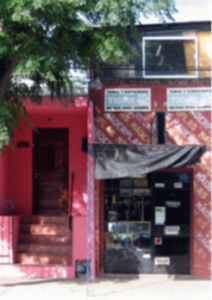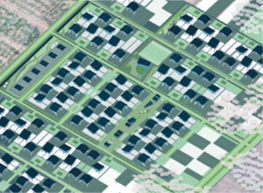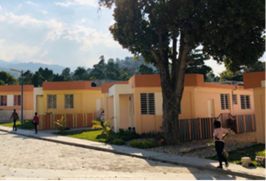Alternative forms of production

ㅤ
‘Self-help’ housing construction in Angola
The concept of ‘owner-builder’ is fundamental to the traditional housing construction process in Angola. The owner acts as both ‘architect’ and ‘contractor’, determining the space layout; arranging the financing; selecting and sourcing building materials, which are usually local; mobilising family labour whenever possible; and hiring tradespersons to do specialist construction work.
Although this self-help process is time consuming, it is well-suited to the financial capacity of the household, and results in the provision of housing at prices that profit-driven contractors would be hard-pressed to achieve. In contrast, the formal sector delivers housing as a ‘product’ relatively quickly, often in standardized forms built of often imported materials. This relatively high-cost housing is usually paid for through bank mortgages over several years. Finance institutions are rarely willing to fund an incremental housing process that may involve a combination of paid and unpaid labour, multiple suppliers and contracts, and unprofitable transaction costs. Indeed, what owner-builders need is to facilitate the traditional housing process through incremental micro-loans.
Cooperative initiatives in Africa
There are over 400 registered housing cooperatives in Kenya, but about one in four is either dormant or has been liquidated.204 The National Co-operative Housing Union (NACHU) has been supporting housing co-operatives since1972. Its main objective is to assist housing cooperatives through the provision of technical and financial services at a cost-effective rate. NACHU has played an important role, as its projects have demonstrated that granting loans to low-income households for shelter improvement is a viable undertaking. However, NACHU has experienced difficulties in its operations owing to its heavy reliance on external funding.
The co-operative movement in Zimbabwe, has contributed significantly to housing provision for many years. According to Housing People of Zimbabwe, a local NGO, over 1,200 registered housing co-operatives are operating in the country. However, housing co-operatives can only borrow from building societies. These are the only finance institutions authorised to provide mortgages for house construction or purchase under the banking system and the legislation governing it.
Co-operative housing models are a relatively recent phenomenon in South Africa, although they come as a major alternative to conventional housing delivery. Tenants’ groups looking to redress inadequate housing conditions, along with a network of local and international NGOs, support co-operative housing. The absence of an enabling legal framework has been a major constraining factor in the development of cooperative housing; but registration of housing co-operatives is now much easier following negotiations with the Government.
Sites-and-service schemes
In Kenya and Zambia, where sites and service schemes were widely embraced, they comprised only five to ten per cent of the total urban low-income housing.
The provision of serviced plots was the favoured approach to affordable housing in Zimbabwe from the late 1970s until the 1990s. The serviced plot schemes were, however, unaffordable for the low-income target groups owing to the high standards on which the government insisted, both for infrastructure and housing.
In Burkina Faso, one of the key areas in which investments in the housing sector have focused is the production of serviced sites for sale.
The National Company for Urban Land was set up for this purpose in 1997. Since the introduction of the new housing policy in 1994, the government in South Africa, in collaboration with various civil society actors, has provided subsidies to more than 1.3 million households in both rural and urban areas through various mechanisms. One of these is the ‘People’s Housing Process’ for self-help construction on conventionally-delivered serviced sites, or with some community participation in servicing.
In 2002, the government of Tanzania launched a project to allocate 20,000 serviced plots to residents who would have otherwise built housing in unplanned areas.
Uruguayan Cooperative Housing Movement

- Figure a: In part due to low population and urbanisation growth, and the role of housing cooperatives, Uruguay’s housing deficit is small compared to its Latin American neighbours. Colonia del Sacramento, Uruguay. Photo © UN-HABITAT. Source: https://unhabitat.org/sites/default/files/download-manager-files/Affordable%20land%20and%20housing%20in%20Latin%20America%20and%20the%20Caribbean.pdf
Like many collective efforts at housing improvements, the Uruguayan cooperative housing movement began in the late sixties as a reaction to a growing housing deficit for low-income communities and dissatisfaction with the available means of accessing housing. Uruguayan housing policy provides the legal and institutional framework that enables cooperatives to serve as the organizing entities for housing creation and also provides financing and subsidy to fund such efforts. The movement has resulted in approximately 200,000 member household accessing housing in over 400 Uruguayan communities over the last three decades.
The Quinta de Batlle Cooperatives – located on the outskirts of Montevideo, the capital of Uruguay – present a strong example of how a collective process can produce high-quality homes and weave an enduring social network for community development. The project resulted in the construction of 206 homes with all necessary infrastructures, set the stage for the construction of a second phase of 350 homes, and brought infrastructure to a poor neighbourhood of nearly 2,000 families. Previously living in range of precarious housing conditions on the urban periphery, the members of the four cooperatives organized to improve their housing conditions utilizing the mutual-aid model.
Federación Uruguaya de Cooperativas de Vivienda por Ayuda Mútua (FUCVAM) – a cooperative umbrella organization – collaborated with the collectives to secure the approval and funding to build. The municipality provided the land and infrastructure for the project and the Ministry of Housing, Territorial Planning and Environment provided the financing, which was administered by the Mortgage Bank of Uruguay. Low-interest financing – including 19 per cent subsidy – funded 80 per cent of the project costs, with the remaining 20 per cent covered by the members’ in-kind labour contributions. FUCVAM connected the various stakeholders, serving as the main negotiator, advising the cooperatives on their initial formation, training them in self-management, and making collaborative connections with other cooperatives.
Once underway, the cooperatives themselves managed the project financial resources, planned the layout of the neighbourhood and homes, mobilized the community’s involvement, and, not least, each household contributed 21 hours of weekly labour to the mutual-aid construction effort. Technical assistance entities assisted the cooperatives with design, construction approvals, loan applications, and monitoring of construction progress.
Households did not know which house will be theirs until post-completion, when homes were assigned by lottery. The owner of the homes and land is the cooperative itself. Families have usage rights but are not, individually, the owners; they must seek the permission of the cooperative to sell their share, which represents their contribution to the project to-date. One strong result of the project is the social network it created. Community organizations stabilize the neighbourhood and have a capacity to solicit other collective benefits, such as new public transport routes. Notably, children of cooperative members have started another two cooperatives to construct a second generation of housing on a nearby plot of land,illustrating how the collective movement has had an enduring influence on approaches to addressing the community’s housing needs.
Housing Support Project in Georgetown (Guyana): a long-term sustainable strategy

- Figure b: Pilot Project in Georgetown Guyana. Authors: Adèle Naudé Santos, Marie Law Adams and Giovanni Bellotti. Students Kyle Branchesi, Sarah Brown, Kadeem Khan, Qianhui Liang, Helena Rong, Nneka Sobers, Yair Titelboim, Yue Wu. Source: https://publications.iadb.org/publications/spanish/document/Vivienda_Qu%C3%A9_viene_de_pensar_la_unidad_a_construir_la_ciudad.pdf
In the last decade, the Government of Guyana has adopted a phased housing approach through its Central Housing and Planning Authority (CH&PA): assisting very low-income households to improve existing housing in situ, whether in formal or informal settlements, and ensure the provision of formal titles and basic infrastructure. CH&PA has adapted progressive housing to the specific conditions of coastal and inland regions. For urban communities, given affordability issues and a lack of accessible and serviced land, CH&PA has supplemented infrastructure and titling with the support of self-build home improvement grants. In the Hinterland region, CH&PA has pioneered the sustainable and inclusive incremental housing approach: it not only supports inter-community housing construction, but also relies on participatory house design and use of materials and local labour. The workshop organized between the Massachusetts Institute of Technology (MIT) and the Inter-American Development Bank (IDB) in Georgetown in 2017 addresses the urban challenges of providing housing that strengthens this community while providing a safe, hygienic and resilient shelter by making focus on the sustainable management of irrigation canals and the prevention of the consequences of floods, storms and high temperatures.
HOME mortgage extension program for housing, Haiti

- Figure c: Housing developed by the Haiti HOME programme. Photo: Haiti HOME. Source: https://publications.iadb.org/publications/spanish/document/Vivienda_Qu%C3%A9_viene_de_pensar_la_unidad_a_construir_la_ciudad.pdf
HOME is a USAID-funded five-year program that seeks to mobilize the private sector to finance and build commercial affordable housing projects in Haiti. Its model is based on facilitating and encouraging market players, from both supply and demand, through a “pay-for-performance model”. It doesn’t impose predefined solutions, but instead provides rewards and encourages creative thinking to mitigate risks, become more efficient and manage human resources. On the supply side, HOME is working with developers and landowners to support commercially driven affordable housing projects. On the demand side, HOME works with financial institutions to address the constraints affecting access to housing in Haiti.
More information:
- UN-Habitat’s Affordable Land and Housing in Africa. Source: https://unhabitat.org/sites/default/files/download-manager-files/Affordable%20Land%20and%20Housing%20in%20Africa.pdf
- UN-Habitat’s Affordable Land and Housing in Africa Report. Source: Sri Lanka, 2005; Ergüden and Precht, 2006:https://unhabitat.org/sites/default/files/download-manager-files/Affordable%20Land%20and%20Housing%20in%20Africa.pdf
- UN-Habitat’s Affordable Land and Housing in Latin America and the Caribbean Report. Source: (Grundström, 2005, Linden, 2005); https://unhabitat.org/sites/default/files/download-manager-files/Affordable%20land%20and%20housing%20in%20Latin%20America%20and%20the%20Caribbean.pdf
- BID’s Report Vivienda ¿Qué viene?: de pensar la unidad a construir la ciudad. Source: https://publications.iadb.org/publications/spanish/document/Vivienda_Qu%C3%A9_viene_de_pensar_la_unidad_a_construir_la_ciudad.pdf